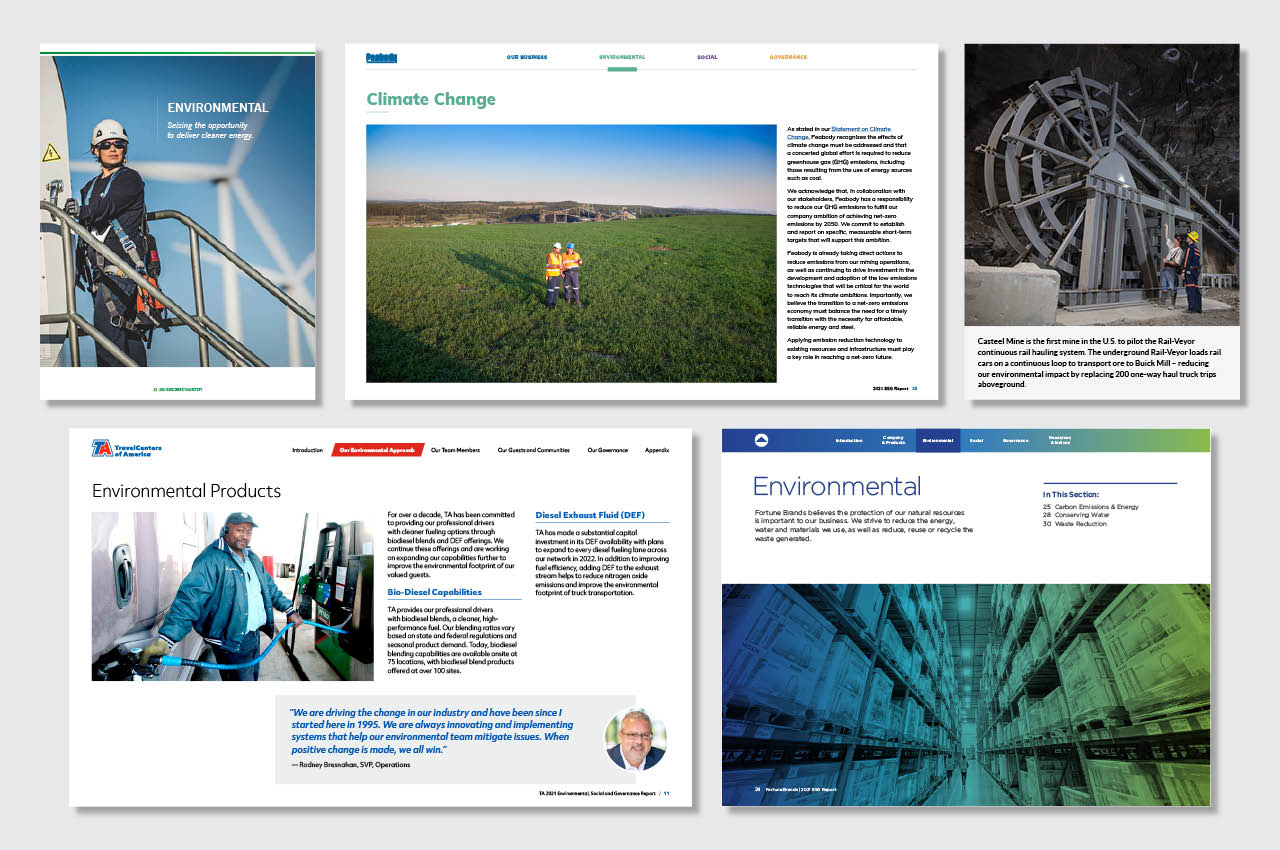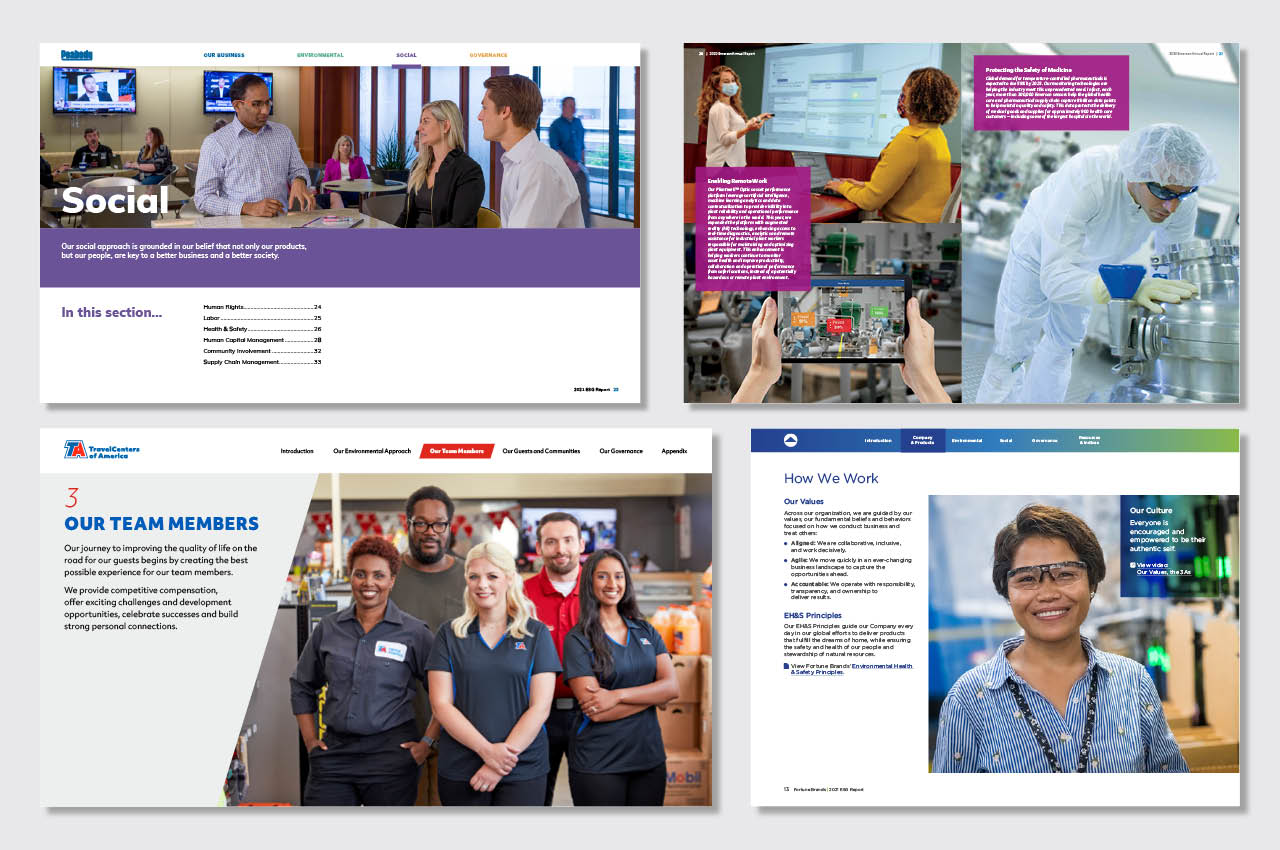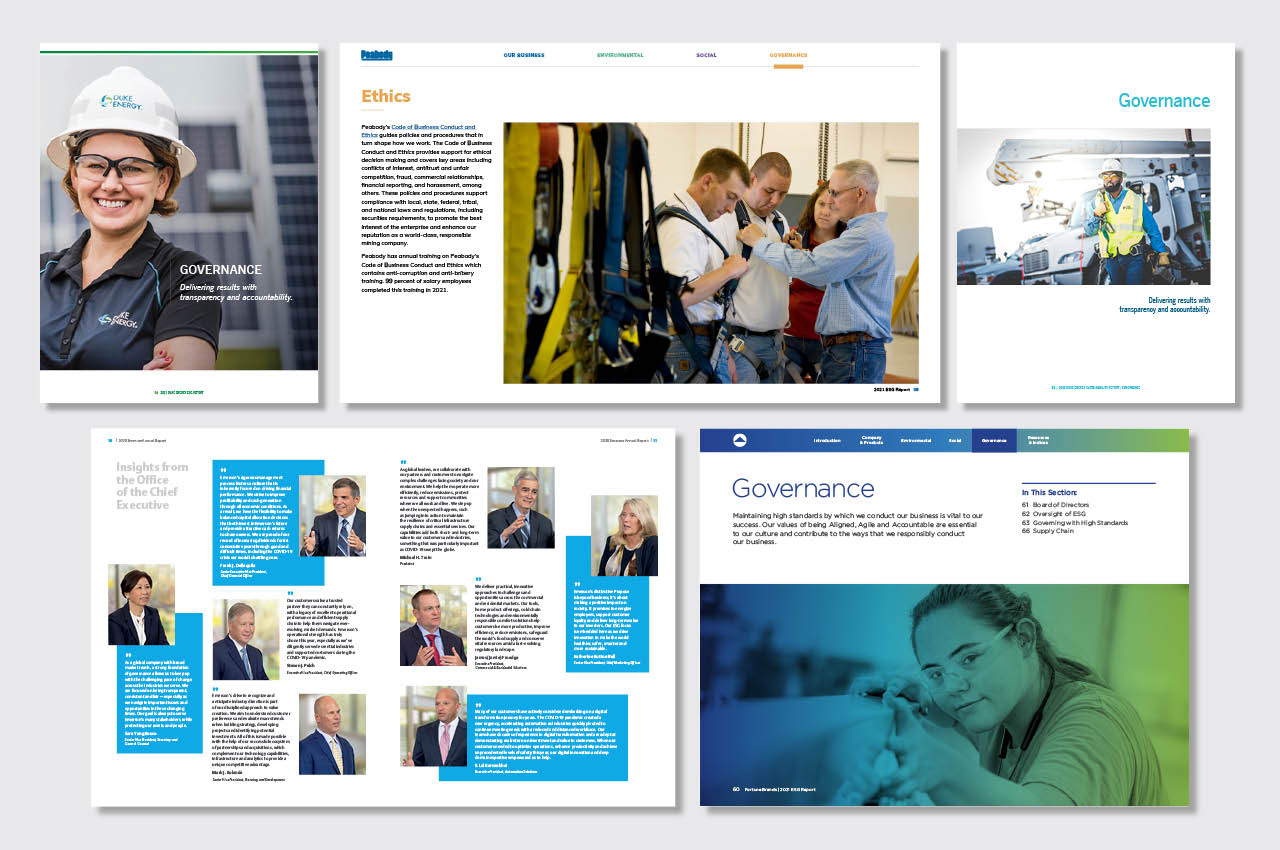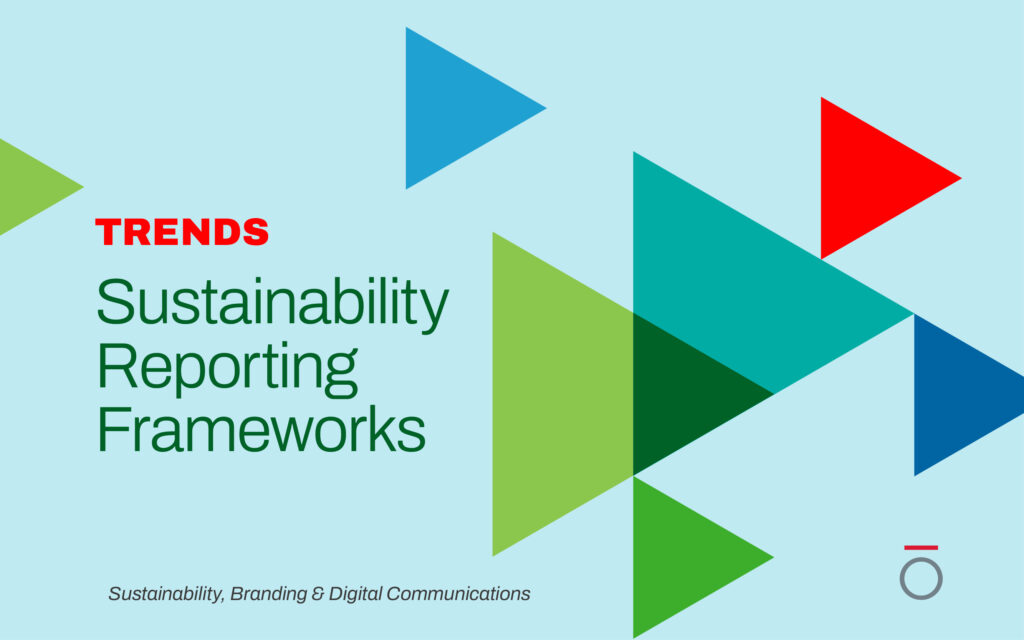Strategies for Impactful ESG Images or Sustainability Photos
Sustainability & ESG, Guides / February 12, 2023
By Paul Gassett
This article was updated in December 2023.
Sustainability and ESG reports often lack relevant or meaningful pictures and ESG images representing the three ESG (environment, social, and governance) pillars and frameworks.
An important rule of thumb is to avoid adding photos that check off various elements of each pillar of ESG. Instead, make sure you add photos that demonstrate your company’s commitments, values, and priorities.
Many of those responsible for creating reports struggle to find pictures and photos within their company’s image library. This is especially true if a company image library does not exist to begin with.

Above are examples of OBATA’s images for sustainability reports, ESG reports, annual reports, and other corporate communications. These quality images represent various environmental, social, and governance issues for ESG and sustainability reporting.
Many of those tasked with creating the report often don’t have the time, staff, or ability to manage and arrange for creating new pictures and, in many cases, do not have a budget for doing so. It can be a difficult conversation to justify a budget for photography.
Investing in authentic and high-quality pictures can be beneficial to a company’s marketing and communications efforts in the long run, making it easier to justify the cost.
In this article, we will discuss:
Photography strategies that support the Environmental pillar

Companies need to demonstrate their environmental commitment and progress. They should incorporate visuals such as images and photographs reflecting their progress toward their environmental objectives.
A growing number of companies are now tracking their Greenhouse Gas emissions (which include direct, indirect, and other sources). Many companies are also tracking their waste and water management initiatives. All are part of their necessary reporting and performance evaluation.
To properly convey this commitment and progress, companies often resort to tired visual clichés. For example the all-too-often-used “seedling in hands” picture or the “overhead view of a winding roadway through a forest” picture. These types of photos won’t add value or distinction to your report. In fact, including too much stock imagery only raises the flag of possible accusations of being inauthentic or worse, “greenwashing”.
Consider environmental issue pictures that provide your audience with a better understanding of your environmental awareness. Focus on examples within your company where there is progress or announcements of new goals or achievements. Examples may include:
- Facilities that have upgraded or have reduced emission outputs
- Facilities that use or have installed solar, wind, or battery power
- Photos of new products or innovative technology that helps improve your environmental performance or the environmental impact on an industry (i.e. vehicle electrification)
Consider including people in your manufacturing or facility pictures. They can add scale and perspective and humanize and personalize the story. Audiences respond well to images with people — it helps create an emotional connection. Since these reports are targeted at real people, your imagery needs to reflect that.
Photography strategies that support the Social pillar

Done well, social and DEI pictures can be a tremendous benefit to employee recruitment, retention, and engagement, translating into a tangible driver of your employee value proposition.
ESG reporting includes the social pillar, which consists of a focus on employee safety, health and welfare, diversity, equity, and inclusion (DEI), as well as community involvement.
It’s considered disingenuous to use stock photography to represent your employee base, even more so when representing diversity in your workplace. Companies should strive to share the outstanding work done by their employees toward social goals by including those employees in the images.
It is advantageous for companies to communicate the commitment of their employees. This includes activities to make a difference in the communities where they live and work. To emphasize this, companies should include images of those activities.
For whom is this important? It is not only important to rating agencies and investors. Today’s consumers expect the brands they support to be socially responsible[1]. Customers are more motivated to buy if they view you as having strong ESG attributes.
And just as importantly, job seekers’ perceptions of corporate social responsibility (CSR) positively relate to job applicant attraction, and employer reputation.[2]
Done well, social and DEI pictures can be a tremendous benefit to employee recruitment, retention, and engagement, translating into a tangible driver of your employee value proposition.
These images demonstrate your company’s commitment to diversity, equity, and inclusion, employee health and safety initiatives, workplace culture, and, most recently, the impacts of the pandemic.
Including well thought-out social photography is an opportunity to:
- Celebrate people and honor your employees
- Alleviate stereotypes or reinforce current perceptions; companies can appear disingenuous when using stock imagery to represent their people
- Document social events that illustrate your workplace culture
Common pushback against using “real” employees in photographs
Including executives and employees in the ESG report creates an authentic and reliable impression of the company’s dedication to social and environmental responsibility.
Those responsible for creating ESG or sustainability reports are concerned about what to do if the people featured in the report leave the organization. Should their image still be used?
The short answer is “yes”. If they worked at the firm at the time of the photo and were involved in that company’s social initiative, then it is a genuine part of the story.
Photography strategies that support the Governance pillar

There are ways to think about Governance ESG pillar and create impactful images. Often companies become too rigid in what constitutes a representative image.
This is probably the most difficult area when it comes to finding and creating new photography. It is often the pillar where a company becomes too rigid or lacks imagination in what constitutes a representative image.
Content for the Governance section of a report ranges from risk management to ethics and compliance to corporate board and supply chain management. These are subjects that do not lend themselves well to being photographed or captured visually.
However, there are ways to think about this ESG pillar and create impactful images. For example:
- Board & Executives: Consider highlighting the board of directors and/or executive team, especially if one or both demonstrate diversity. This may include headshots or team group pictures. It is often difficult to have all board members present in a room simultaneously. However, a group picture can be assembled from multiple images. Read more about this here.
- Risk management and governance: Often images of ethics programs or icons that reflect the initiative can be designed and developed. In some instances, a video featuring company leadership talking about such a program may provide an ideal way to communicate these initiatives. This video can be housed on the company website or YouTube channel and linked to the report.
- Infographics: Infographics may be the perfect substitute for photography for the Governance section of an ESG report. Read more here.
Trends in Sustainability and ESG photography
Relying on photos taken by a smartphone
- Photography taken with a smartphone typically suffer from image quality issues such as low resolution. Companies often resort to this option to capture local community support efforts. While grass-roots in feel, these images are typically poorly framed, poorly lit, and/or poorly directed.
There is a danger in including these images in a public-facing document. When you’re trying to communicate your company’s ESG commitments, it can project a feeling that the company didn’t consider it important enough to hire a professional photographer.
Stock photography is often used to represent generic environmental themes
- We typically see this when there is a deficit in company-owned imagery.
At OBATA, we come across familiar stock images in many reports. For example, a child tossing a folded paper airplane, a small tree-in-hand picture, and numerous others. But, these images blend in with many other reports. They do little to differentiate your company’s sustainability story from other companies.
Adding video content of executive action and progress
- Video content of executive action and progress is becoming more and more relevant. Viewing videos of company executives and staff can make an ESG report more personal. It can show readers that the company is truly devoted to its environmental, social, and governance objectives.
The Key Takeaway
The world of digital photography has come a long way, making it easy for anyone with a smartphone to capture images. However, it’s important to remember that the experience and knowledge of a professional photographer cannot be replaced. Amateurs may produce inconsistent and low-quality images, negatively impacting the company’s brand.
Professional photography can advance the theme while building the corporate brand. Investing in high-quality photography that aligns with the corporate brand can significantly impact the company’s reputation.
Utilizing low-quality or cheap images taken by amateurs may seem like a cost-effective solution, but it can make the company appear unprofessional and undermine its credibility. By being original and creative, a company can distinguish itself from its competitors and make a positive impact on its audience.
Create Impactful ESG and Sustainability Images
It is advisable to collaborate with a firm that specializes in the design and production of ESG and sustainability reports. OBATA has planned and executed detailed sustainability and ESG pictures in thirty-seven countries and has designed over 50 CSR, sustainability, and ESG reports.
Developing an ESG report or sustainability report is good for business. Learn the top reasons why companies create an ESG report.
[1] Corporate social responsibility and job applicant attraction: A moderated-mediation model
[2] Consumers Expect the Brands they Support to be Socially Responsible


